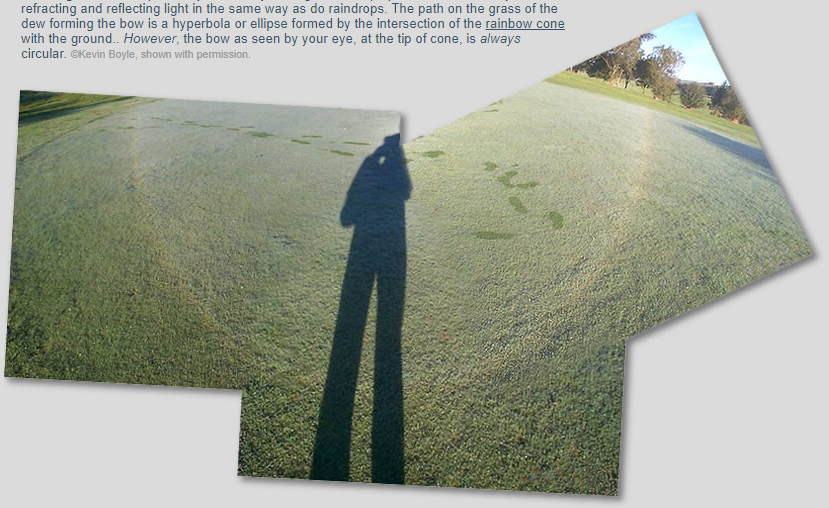Dew Bow
Exploring the Enigmatic Dew Bow
Have you ever witnessed a captivating phenomenon known as the dew bow? This ethereal display of light is formed by the refraction and reflection of sunlight on dew drops, much like how raindrops create rainbows. While the path of the dew forming the bow on the ground may appear as a hyperbola or ellipse, the bow seen by our eyes is always circular. Let's delve deeper into this enigmatic atmospheric optics phenomenon and unravel its mysteries.
The Science Behind the Dew Bow
When the sun's rays encounter dew-covered grass or other surfaces, they undergo a process called refraction. This bending of light causes the rays to change direction as they pass from one medium (air) to another (water droplet). As a result, the light is dispersed into its component colors, just like in a prism. This dispersion gives rise to the vibrant hues that grace the dew bow.
Formation and Appearance
The formation of a dew bow requires two essential elements: sunlight and dew-covered surfaces. In the early morning or late evening, when the angle of the sun is low, the conditions are ideal for the creation of these mesmerizing arcs of light. The dew drops act as miniature prisms, refracting and reflecting the sunlight to produce a circular bow.
The appearance of a dew bow is similar to that of a rainbow, but with some distinctive characteristics. Unlike rainbows, which form a semicircle, dew bows are complete circles. The circular shape arises due to the spherical nature of water droplets on the grass, causing light to be refracted and reflected at various angles. This dispersion of light creates an exquisite circle of colors, often seen just above the grassy surface.
The Elusive Hyperbola or Ellipse
While the dew bow itself appears circular to our eyes, the path formed by the dew drops on the ground can take on different shapes. Under certain conditions, such as when the sun is low on the horizon, the intersection of the rainbow cone with the ground may create a hyperbola or ellipse. These geometric patterns are formed by the intricate interplay between the angle of sunlight, the curvature of the droplets, and the observer's position.
Capturing the Beauty
Photographing a dew bow can be a challenging yet rewarding endeavor. To capture this ethereal phenomenon, one must find the perfect balance between lighting conditions, composition, and timing. A dew-covered landscape, illuminated by the gentle rays of the rising or setting sun, provides an ideal backdrop for capturing the beauty of a dew bow. Patience and keen observation are key to seizing the moment when the colors of the bow are at their most vibrant.
Other Similar Phenomena
The dew bow shares many similarities with other atmospheric optics phenomena. Here are a few related wonders that you might encounter:
- Rainbows: The most well-known atmospheric optical phenomenon, rainbows form when sunlight interacts with raindrops in the air.
- Fogbows: Also known as white rainbows or cloudbows, fogbows occur when sunlight refracts through tiny water droplets in fog, creating a pale, colorless bow.
- Moonbows: Moonbows are rainbows that form at night when moonlight is refracted and reflected by raindrops or water mist.
Appreciating Nature's Artistry
The dew bow serves as a reminder of the remarkable beauty that can be found in the natural world. Its ephemeral presence evokes a sense of wonder and awe, captivating our imagination with its exquisite colors and delicate form. Next time you find yourself in the presence of morning dew and gentle sunlight, take a moment to appreciate this enchanting display of atmospheric artistry.
Morning dewbow captured by Kevin Boyle. Large dew drops produce the bow by refraction and reflecting light in the same way as do raindrops. The path on the grass of the dew forming the bow is a hyperbola or ellipse formed by the intersection of the rainbow cone with the ground. However the bow seen by your eyes at the tip of cone, is always circular.

Note: this article has been automatically converted from the old site and may not appear as intended. You can find the original article here.
Reference Atmospheric Optics
If you use any of the definitions, information, or data presented on Atmospheric Optics, please copy the link or reference below to properly credit us as the reference source. Thank you!
-
<a href="https://atoptics.co.uk/blog/dew-bow/">Dew Bow</a>
-
"Dew Bow". Atmospheric Optics. Accessed on December 19, 2024. https://atoptics.co.uk/blog/dew-bow/.
-
"Dew Bow". Atmospheric Optics, https://atoptics.co.uk/blog/dew-bow/. Accessed 19 December, 2024
-
Dew Bow. Atmospheric Optics. Retrieved from https://atoptics.co.uk/blog/dew-bow/.